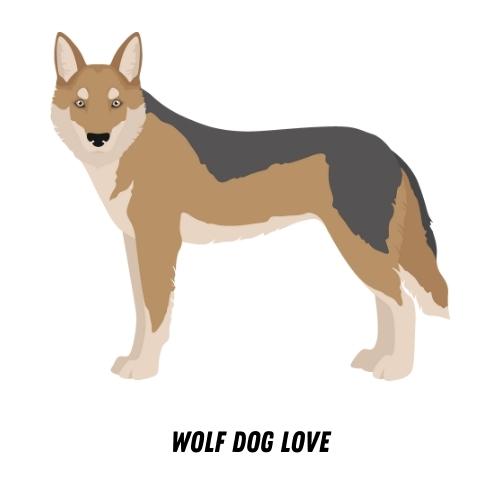Introduction to Wolf Dog Breeds
Wolf dogs are fascinating creatures that have captured the interest of many dog lovers around the world. They are a unique blend of domestic dog and wild wolf, resulting in a breed that is both familiar and exotic. In this article, we will delve into the concept of wolf dog breeds and explore their history and origin.
- Understanding the concept of Wolf Dog Breeds
- History and origin of Wolf Dogs
Wolf dogs, as the name suggests, are a hybrid breed created by mating a domestic dog with a wild wolf. This unique combination results in a breed that carries traits from both its parents. Wolf dogs are known for their intelligence, strength, and loyalty. However, they also inherit the wild instincts of their wolf parent, making them more challenging to handle than typical domestic dogs.
The history of wolf dogs dates back to prehistoric times. Ancient humans first domesticated wolves thousands of years ago, leading to the creation of the first dog breeds. Over time, selective breeding led to the development of different dog breeds, each with its unique traits. The wolf dog, as we know it today, is a result of deliberate cross-breeding between domestic dogs and wolves in more recent times. This was often done to create a breed that combined the loyalty and companionship of a dog with the strength and survival instincts of a wolf.
As we continue, we will explore the different variations of wolf dogs, their characteristics, and the diversity within this breed. This will provide a deeper understanding of these captivating creatures and their place in the world of canine breeds.
Embracing Wolf Dog Variations
Wolf Dogs are a fascinating blend of domestic dog and wild wolf. They are unique, captivating, and come in a variety of forms. Let’s delve deeper into understanding these intriguing creatures.
Understanding Wolf Dog Breeds
Before we explore the variations, it’s important to understand what we mean by ‘Wolf Dog’ and clear up some common misconceptions.
- Defining the term ‘Wolf Dog’
- Common misconceptions about Wolf Dogs
A Wolf Dog, as the name suggests, is a hybrid between a domestic dog and a wild wolf. They are not a breed in the traditional sense, but rather a mix of genetics from both species. This blend results in an animal that has traits of both its dog and wolf ancestors.
One common misconception is that Wolf Dogs are simply wild wolves. This is not true. While they do have wolf genetics, they also have the genetics of domestic dogs. This means they can exhibit behaviors of both, making them unique and sometimes unpredictable.
Another misconception is that all Wolf Dogs are dangerous. Like any dog, a Wolf Dog’s temperament can vary greatly depending on its upbringing, socialization, and treatment. It’s important to remember that these animals are not for everyone and require knowledgeable and committed owners.
Now that we’ve defined what a Wolf Dog is and addressed some common misconceptions, we can begin to explore the wonderful variations of this unique hybrid.
Different Wolf Dog Breeds
There are several different breeds of wolf dogs, each with their unique characteristics and traits. Let’s explore some of the most popular ones.
-
Alaskan Malamute
The Alaskan Malamute is a large breed of domestic dog, known for its strength and endurance. They are often mistaken for wolves due to their similar physical appearance. However, they are very friendly and make excellent family pets. They have a thick, coarse coat that comes in various colors, including black, gray, sable, and red.
-
Siberian Husky
Siberian Huskies are medium-sized dogs that are known for their striking blue or multicolored eyes and their wolf-like features. They are agile, energetic, and love to run. Siberian Huskies have a thick coat that comes in a variety of colors and patterns. Despite their wolf-like appearance, they are generally friendly and good with children.
-
German Shepherd
German Shepherds are one of the most popular dog breeds in the world. They are large, strong dogs that are often used for work in police, guard, and search-and-rescue roles. German Shepherds have a dense double coat that is most often black and tan, but can also be sable or all black. They are intelligent, loyal, and versatile, making them excellent family pets.
-
Other breeds
There are many other breeds of wolf dogs, including the Czechoslovakian Wolfdog, the Saarloos Wolfdog, and the Utonagan, among others. Each of these breeds has unique characteristics and traits that make them special. It’s important to research and understand the specific needs and behaviors of each breed before deciding to adopt or purchase a wolf dog.
Remember, owning a wolf dog is a big responsibility. These dogs require a lot of exercise, mental stimulation, and socialization. They are not suitable for everyone, so make sure you are fully prepared before bringing one into your home.
Wolf Dog Breed Characteristics
Wolf dogs are unique and fascinating creatures. They combine the wild beauty and instincts of a wolf with the loyalty and companionship of a dog. Let’s dive into the physical characteristics that make these breeds stand out.
Physical Characteristics
Physical traits are one of the most noticeable aspects of wolf dogs. These characteristics can vary greatly depending on the specific breed and the percentage of wolf genetics. However, there are some common features that most wolf dogs share.
- Size and Weight
- Coat and Color
Wolf dogs are generally larger than most domestic dog breeds. They typically stand between 26 to 34 inches tall at the shoulder. As for weight, it can range from 70 to 180 pounds, depending on the specific breed and gender. Males are usually larger and heavier than females.
Wolf dogs have a dense double coat that helps them withstand cold temperatures. The outer coat is straight and harsh, while the undercoat is soft and insulating. The color of their coat can vary widely, from white, gray, brown, to black, often with mixed patterns. This diversity in coat color is a result of their mixed heritage.
In conclusion, the physical characteristics of wolf dogs make them a unique and beautiful breed. Their size and weight, combined with their distinctive coat and color, are a testament to their wild ancestry. However, it’s important to remember that these traits can vary greatly depending on the specific breed and the percentage of wolf genetics.
Behavioral Characteristics
Understanding the behavior of wolf dogs is crucial for anyone considering adopting one. Let’s delve into their temperament and the importance of training and socialization.
- Temperament
- Training and Socialization
Wolf dogs are known for their unique temperament. They are typically intelligent, independent, and energetic. They are also known to be loyal and protective of their families. However, their behavior can vary widely depending on their specific breed and individual personality. Some wolf dogs may be more outgoing and friendly, while others may be more reserved or even shy.
It’s important to remember that wolf dogs are not like typical domestic dogs. They have a strong instinctual behavior, which can make them more challenging to handle. They require a lot of mental stimulation and physical exercise to stay happy and healthy.
Training and socialization are key aspects of raising a well-behaved wolf dog. Due to their intelligence and independent nature, wolf dogs can be a bit challenging to train. They require consistent, positive reinforcement training methods from a young age. It’s also important to provide them with plenty of socialization opportunities to help them become well-adjusted adults.
Proper socialization involves exposing your wolf dog to a variety of people, environments, and other animals in a controlled and positive manner. This helps them learn to be comfortable and confident in different situations. It’s best to start socialization as early as possible, ideally when your wolf dog is still a puppy.
In conclusion, understanding and respecting the behavioral characteristics of wolf dogs is essential for a successful and rewarding relationship with these unique animals. They require a committed and knowledgeable owner who is willing to invest time and effort into their training and socialization.
Types of Wolf Dogs
Wolf dogs are a fascinating blend of domestic dog and wild wolf. They come in various types, each with its unique characteristics. Let’s explore the three main types: High-content, Low-content, and Mixed-content Wolf Dogs.
-
High-content Wolf Dogs
High-content Wolf Dogs are those that have a higher percentage of wolf genetics compared to dog genetics. They often closely resemble wild wolves in both appearance and behavior. These wolf dogs are known for their intelligence, agility, and strong instinctual behaviors. They require a lot of space and a knowledgeable owner who understands their unique needs.
-
Low-content Wolf Dogs
Low-content Wolf Dogs have a lower percentage of wolf genetics, meaning they are more dog than wolf. They are generally easier to handle and adapt better to living in a domestic environment. However, they still retain some wolf-like traits, such as a strong prey drive and a tendency to be more independent than most domestic dogs.
-
Mixed-content Wolf Dogs
Mixed-content Wolf Dogs have an almost equal mix of wolf and dog genetics. Their behavior and appearance can vary greatly, even within the same litter. Some may look and act more like a wolf, while others may be more dog-like. These wolf dogs can be unpredictable, as their behavior can lean more towards their wolf or dog ancestry.
In conclusion, the type of Wolf Dog you choose to bring into your home should depend on your lifestyle, experience with dogs, and understanding of wolf behaviors. Regardless of the type, all Wolf Dogs require a committed owner who is willing to invest time, energy, and resources into their care.
Wolf Dog Breed Differences
Wolf dogs are a fascinating breed, and they come with their unique set of characteristics. In this section, we will delve into the differences in behavior among wolf dog breeds.
Differences in Behavior
Behavioral differences in wolf dogs can be quite noticeable, especially when it comes to aggression levels and social behavior. Let’s explore these two aspects.
- Aggression levels
- Social behavior
Wolf dogs, like any other breed, can display varying levels of aggression. This largely depends on their upbringing, training, and genetics. Some wolf dogs may have a higher tendency towards aggression, especially if they feel threatened or if their territory is invaded. However, with proper training and socialization, they can learn to manage their aggression effectively.
Wolf dogs are known for their pack mentality, which influences their social behavior. They are usually very loyal to their family or ‘pack’ and can be protective. However, their social behavior with other dogs or humans can vary. Some wolf dogs are quite sociable and enjoy the company of others, while others may be more reserved or even aloof. This can also be influenced by their upbringing and socialization experiences.
In conclusion, while there are general tendencies in the behavior of wolf dogs, individual differences can be significant. It’s important to remember that every wolf dog is unique and will have its own personality and behavioral traits.
Differences in Physical Attributes
Wolf dogs, like all dogs, come in many shapes and sizes. The physical attributes of these magnificent creatures can vary greatly. Let’s explore two key physical differences: size and coat variations.
- Size Variations
Wolf dogs can range in size from medium to large. The size of a wolf dog can be influenced by the specific breed of dog in its lineage. For example, a wolf dog that has a German Shepherd in its ancestry will likely be larger than a wolf dog that comes from a smaller breed, like a Border Collie. On average, wolf dogs can weigh anywhere from 60 to 120 pounds, and stand 26 to 34 inches tall at the shoulder.
- Coat Variations
Wolf dogs also exhibit a wide range of coat variations. These can range from short to long and straight to curly. The color of their coats can also vary greatly. Some wolf dogs have a coat that is a solid color, like white, black, or brown. Others may have a mix of colors, often in patterns similar to those seen in wolves, such as a blend of gray, black, and white. The thickness of their coat can also vary, with some wolf dogs having a double coat for extra warmth in colder climates.
Understanding these physical differences can help potential owners better prepare for the needs of their wolf dog. For instance, larger wolf dogs will require more space and exercise, while those with thicker coats may need more grooming and care, especially in warmer climates.
In conclusion, the size and coat variations of wolf dogs are just two of the many factors that make each one unique. These differences are part of what makes owning a wolf dog such a special experience.
Diversity in Wolf Dog Breeds
Wolf Dogs are an intriguing blend of wild and domesticated canines. This unique combination results in a wide array of breeds, each with its own distinct characteristics. The diversity in Wolf Dog breeds is truly fascinating and worth exploring. Let’s dive into the world of Wolf Dogs and appreciate the diversity they offer.
- Exploring the wide range of Wolf Dog breeds
Wolf Dogs come in a variety of shapes, sizes, and colors. Some breeds lean more towards their wolf ancestry, while others exhibit more dog-like traits. This diversity is a result of the different breeds of dogs that have been crossed with wolves over the years.
For instance, the Saarloos Wolfdog, a breed developed in the 20th century, is a cross between a German Shepherd and a Eurasian Grey Wolf. This breed is known for its wolf-like appearance and behavior. On the other hand, the Czechoslovakian Wolfdog, another popular Wolf Dog breed, is a mix of a German Shepherd and a Carpathian Wolf. This breed is known for its loyalty and trainability, traits more commonly associated with domestic dogs.
These are just two examples of the many Wolf Dog breeds available. Each breed has its own unique set of traits, making the world of Wolf Dogs incredibly diverse and fascinating to explore.
- Appreciating the diversity in Wolf Dogs
Appreciating the diversity in Wolf Dogs goes beyond just admiring their physical characteristics. It’s about understanding the unique blend of traits that each breed brings to the table. From their behavior and temperament to their health and lifespan, each Wolf Dog breed is unique in its own way.
For example, some Wolf Dog breeds are known for their high energy levels and need for regular exercise, while others are more laid back and content with a more sedate lifestyle. Some breeds are known for their intelligence and trainability, while others are more independent and can be a challenge to train.
Understanding and appreciating this diversity is key to being a responsible Wolf Dog owner. It helps ensure that you choose a breed that fits well with your lifestyle and can provide the right environment for your Wolf Dog to thrive.
In conclusion, the world of Wolf Dogs is filled with a wide range of breeds, each with its own unique set of characteristics. This diversity is what makes Wolf Dogs such fascinating creatures to explore and appreciate.
Breed Variations in Wolf Dogs
Wolf dogs, as the name suggests, are a unique blend of domestic dog and wild wolf. This combination results in a diverse range of breeds, each with its own distinct characteristics. In this section, we will delve into two specific breeds – the Alaskan Malamute and the Siberian Husky – to understand the variations in wolf dog breeds.
Case Studies
Let’s explore these breeds in detail through the following case studies:
- Case study 1: Alaskan Malamute
- Case study 2: Siberian Husky
The Alaskan Malamute is a breed that is often mistaken for a wolf due to its similar physical appearance. However, this breed is entirely domesticated and has been bred for thousands of years to work as sled dogs in harsh Arctic conditions. They are known for their strength, endurance, and ability to carry heavy loads over long distances.
Despite their wolf-like appearance, Alaskan Malamutes are typically friendly, affectionate, and good with children. They are also known for their intelligence and independence, which can sometimes translate into stubbornness. They require a significant amount of exercise and mental stimulation to stay happy and healthy.
The Siberian Husky is another breed that bears a striking resemblance to wolves. Like the Alaskan Malamute, they were bred to work as sled dogs in cold climates. However, Siberian Huskies are generally smaller and faster than Alaskan Malamutes.
Siberian Huskies are known for their friendly and outgoing nature. They are typically good with other dogs and enjoy being part of a pack. They are also known for their energy and need for regular exercise. Despite their friendly nature, Siberian Huskies have a strong prey drive and may not be suitable for homes with small pets.
In conclusion, while both the Alaskan Malamute and Siberian Husky share similarities with wolves, they are distinct breeds with their own unique characteristics. Understanding these differences is crucial for anyone considering adopting a wolf dog.
Conclusion
In this article, we’ve explored the fascinating world of Wolf Dog breeds. We’ve delved into their characteristics, types, and the diversity that exists within this breed group. Now, let’s summarize the key takeaways and share some final thoughts on embracing Wolf Dog diversity.
- Key takeaways about Wolf Dog breeds
- Final thoughts on embracing Wolf Dog diversity
Wolf Dogs are a unique blend of domestic dog and wild wolf, resulting in a breed that is both familiar and exotic. They come in a variety of types, each with its own distinct characteristics. Understanding these breeds requires acknowledging their wolf heritage and appreciating their individual traits. They are intelligent, loyal, and require a knowledgeable and committed owner.
Embracing the diversity among Wolf Dogs is about appreciating each breed for its unique qualities. It’s about understanding that a Wolf Dog’s behavior and temperament can vary greatly depending on its genetic makeup. It’s also about recognizing that owning a Wolf Dog is a significant commitment that requires a deep understanding of the breed and its needs. In the end, the diversity among Wolf Dogs is a testament to the richness and complexity of canine genetics and the enduring bond between humans and dogs.
In conclusion, Wolf Dogs are a fascinating and diverse group of breeds. They offer a unique blend of the familiar and the exotic, and owning one can be a rewarding, albeit challenging, experience. By understanding and embracing their diversity, we can better appreciate these remarkable animals and the unique qualities they bring to our lives.








